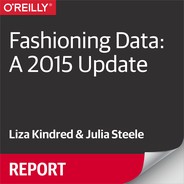Chapter 1. Fashion: What Has It Done for You Lately?
When it comes to big data, maybe a lot.
Fashion is an industry that struggles for respect—despite its enormous size globally, it is often viewed as frivolous or unnecessary.
And it’s true—fashion can be spectacularly silly and wildly extraneous. But somewhere between the glitzy, million-dollar runway shows and the ever-shifting hemlines, a very big business can be found. One industry profile of the global textiles, apparel, and luxury goods market reported that fashion had total revenues of $3.05 trillion in 2011, and is projected to create $3.75 trillion in revenues in 2016.
The majority of these purchases are made not out of necessity, but out of a desire for self-expression and identity, two remarkably difficult things to quantify and define. Yet somehow myriad different businesses are finding clever ways to use big data to do just that—to turn fashion into bits and bytes, as much as threads and buttons.
In these shrewd applications of big data are lessons for industries of all types. From the lessons of a complex lifecycle to the methods of new startups, and from merging humanity with machine learning to improving visual search, the information in this report will change the way you think about the applications of big data.
So how can we turn the emotional aspects of fashion into actionable data? What can be learned from the fashion industry that differs from what is already familiar to the Strata audience? How can humans and machines work together to help solve problems that are at once sentimental and pragmatic? We aim to address these questions in this report.
What’s Inside
This updated report takes a look at the important ways that fashion has used big data to address the complications of the industry, the importance of algorithms, and one of the biggest technical challenges in fashion and beyond: visual search. We also explore the complexities of natural language processing and its implications across industries.
Don’t like to shop? Don’t worry. This report encompasses the essence of how fashion brands and startups are using data to drive big sales—and how you can, too. It will also become clear that there is an overlap between fashion and other, more technical industries—relating to everything from using algorithms to relying on natural language processing. In addition, we can learn lessons from the most innovative fashion start-ups that apply well beyond the fashion industry.
One of the things that fashion has always done very well is to have two-way conversations with customers. “Most companies—Google, Yahoo!, Netflix—use what they call inferred attributes: they guess. We don’t guess, we ask,” says Eric Colson, who spent six years at Netflix before becoming the Chief Algorithms Officer at Stitch Fix, a personalized online shopping and styling service for women. This is an attitude that most other industries would do well to incorporate.
